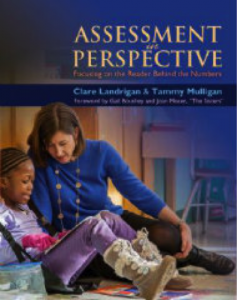Assessment in Perspective: Focusing on the Reader Behind the Numbers
Assessment in Perspective: Focusing on the Reader Behind the Numbers
By Clare Landrigan & Tammy Mulligan
(Stenhouse Publishers, 2013 – Learn more)

Assessment is a hot topic in educational circles. RTI, Common Core, high-stakes mandated tests – the pressure is on to demonstrate growth based on data. But the question still remains, how do we use the data to focus on the reader? In Assessment in Perspective: Focusing on the Reader Behind the Numbers, Clare Landrigan and Tammy Mulligan offer a guide to assessments and their benefits.

- Moving Beyond the numbers: Finding the Stories of Our Readers
- Why Assessment? Why Now?
- Assessment Literacy
- Triangulating Assessment
- Assessing Authentically, Every Day
- The Student’s Role in Assessment
Case studies and stories interspersed throughout the chapters offer practical examples. The stories support the rationale behind each concept or new idea presented. Often the stories “slap” you in the face when you come to realize that assessment has been merely a collection of data but has not changed your teaching or approach. What a humbling thought.
The authors list three principles of assessment:
- Assessment is more than a number.
- Assessment and instruction are inseparable.
- Our instruction can meet high standards and still be developmentally appropriate.
Purposeful assessment is based on assessment. Assessment allows us to differentiate our teaching to meet our readers’ needs. When we instruct, we watch how readers respond and use these data to adjust our instruction.”
The “assessment literacy” chapter details how assessment tools are grouped into different categories: quantitative or qualitative; diagnostic, formative, or summative; informal or formal. Each area is explained in depth but also connects the assessment to a purpose. Charts and illustrations sort and categorize the various areas of assessment. “It is not enough for us to understand how assessments are designed, scored, and administered. We also need to understand exactly what an assessment is measuring in terms of reading.”
Triangulating – analyzing, questioning, and assessing – is a process that taps into multiple sources of data to find the stories of readers. Multiple pieces of data on a student push the teacher to ask more questions. “What is my purpose? What method should I use? What types of data do I need?” Visual displays can also be used to triangulate data. The visual representation causes the teacher to ask more questions and dig deeper. Bar graphs, data walls, conference notes, and messy sheets are some of the illustrations included in the chapter on triangulating assessment.
Practical authenticity
Assessment needs to be an authentic part of our classroom practice. The authors offer a practical means of integrating assessment without burdening the teacher with more work. Practical structures and systems for organizing notes are discussed with detailed illustrations. An appendix includes templates for conferences, lesson planning, and guided practice.
Assessment in Perspective is not a quick read but a resource filled with useful ideas that need to be digested slowly as authentic assessment becomes a part of your day-to-day teaching. The ideas contained in this book will challenge you to maximize assessments to change instruction in your classroom for the better.
Sandy Wisneski is lead teacher at Catalyst Charter Middle School which opened in the fall of 2013. She is the district webmaster, tech mentor, yearbook advisor as well as new teacher mentor. Over the past 37 years she has become certified as a Flat Classroom Teacher and obtained her masters in reading. She enjoys challenging students to “take ownership” for their learning and to be effective digital citizens in the world.


































